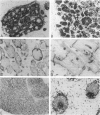Abstract
The neural cell adhesion molecule (NCAM) was discovered in a search for cell surface antigens of chicken neurons that contribute to cell adhesion and pattern formation during development. Homologous adhesion molecules have been identified in several species, including humans. In this immunohistochemical study, the authors examine the role of human NCAM in tumor diagnosis. The authors used a monoclonal antibody (MAb), 5.1H11, to examine NCAM immunoreactivity in frozen sections of more than 450 tumors, including more than 80 small round cell tumors (SRCT) of childhood and adolescence (neuroblastomas, Ewing's sarcomas [ES], peripheral neuroepitheliomas [PN], primitive neuroectodermal tumors [PNET], esthesioneuroblastomas, malignant ectomesenchymoma, medulloblastomas, small cell osteosarcomas, mesenchymal chondrosarcomas, embryonal rhabdomyosarcomas, and lymphomas). The authors show that 1) neuroblastomas and primary brain tumors are NCAM+; 2) ES, most PN/PNETs, and melanomas are NCAM-; 3) embryonal rhabdomyosarcomas and various other sarcomas are NCAM+; 4) neuroendocrine tumors are NCAM+; 5) subsets of carcinomas of kidney, ovary, lung and other organs are NCAM+; and 6) lymphoid tumors are NCAM-. Tests with normal fetal and adult tissues indicate that these findings reflect only in part the NCAM phenotypes of corresponding normal tissues. Notably the NCAM- phenotype of ES and PN/PNET is not explained by current histogenetic models for these tumors, which suggest a primitive neuroectodermal origin. Finally the authors show that NCAM expression among SRCT has an inverse relationship with the expression of p30/32MIC2, a cell surface antigen of ES and PN/PNET detected with MAb HBA71. These results suggest that immunohistochemical assays for NCAM and p30/32MIC2 expression may aid in the further characterization of SRCT of childhood and adolescence.
Full text
PDF

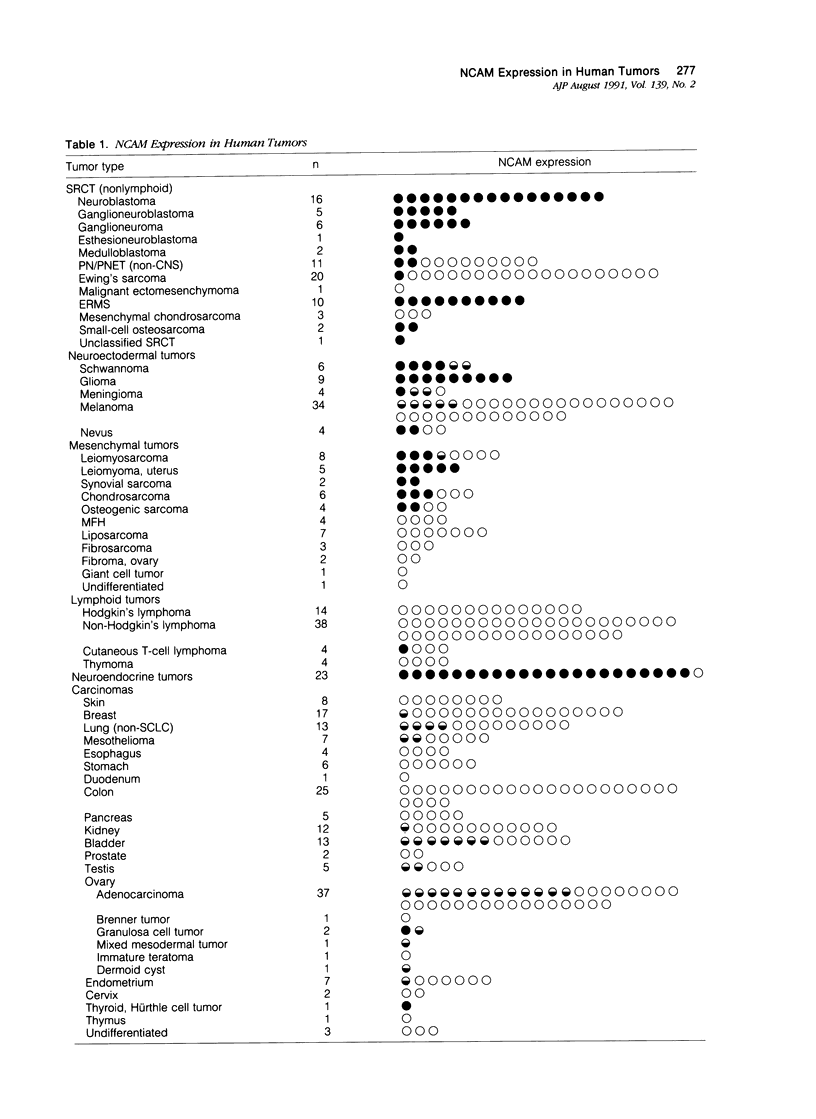


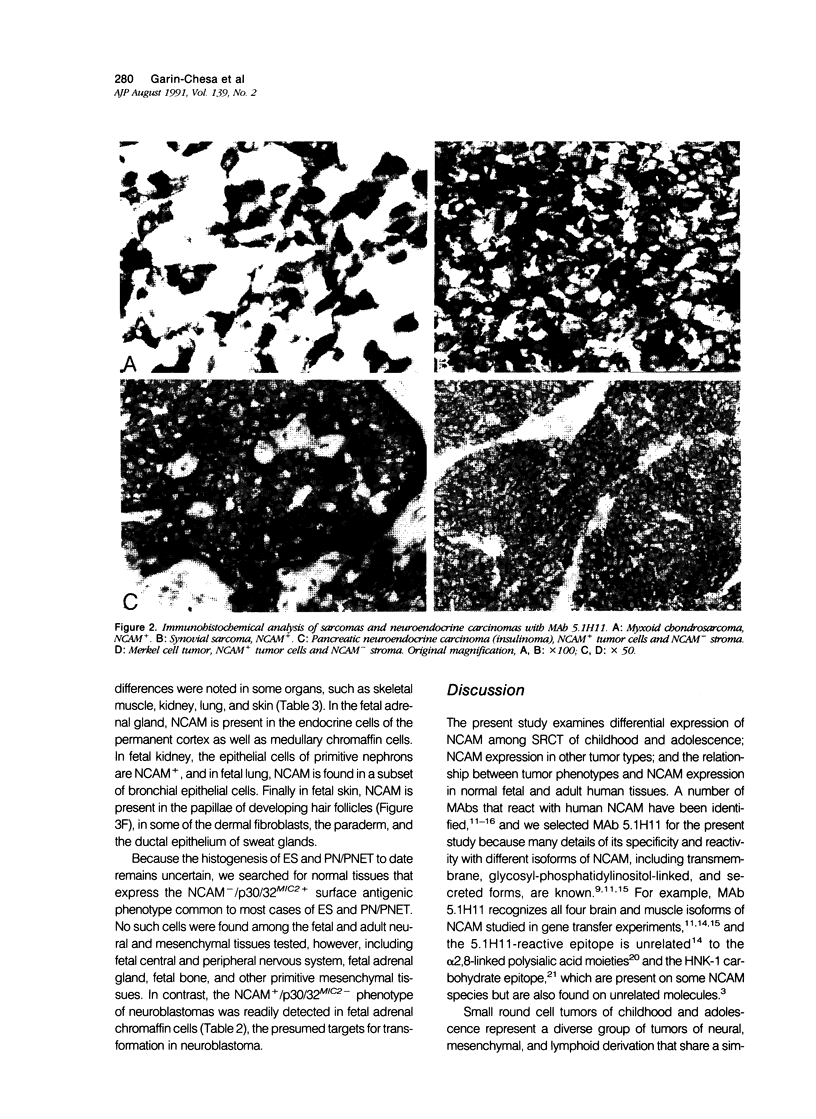
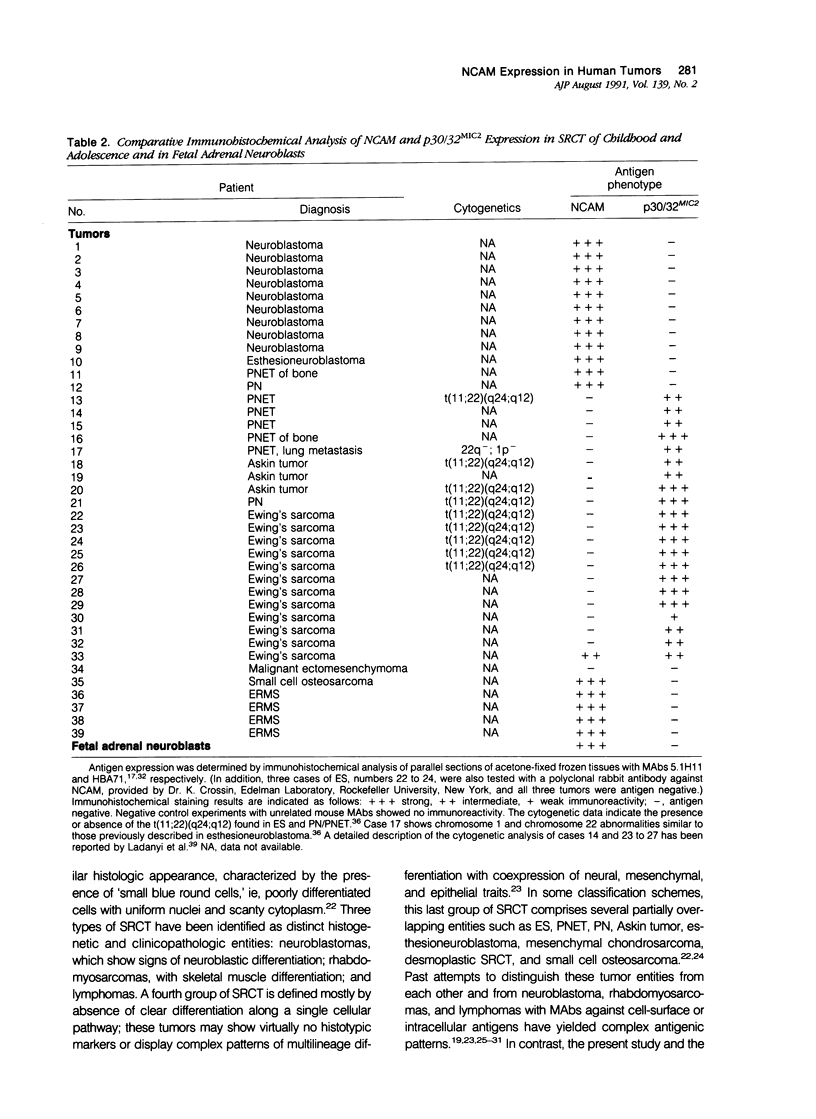
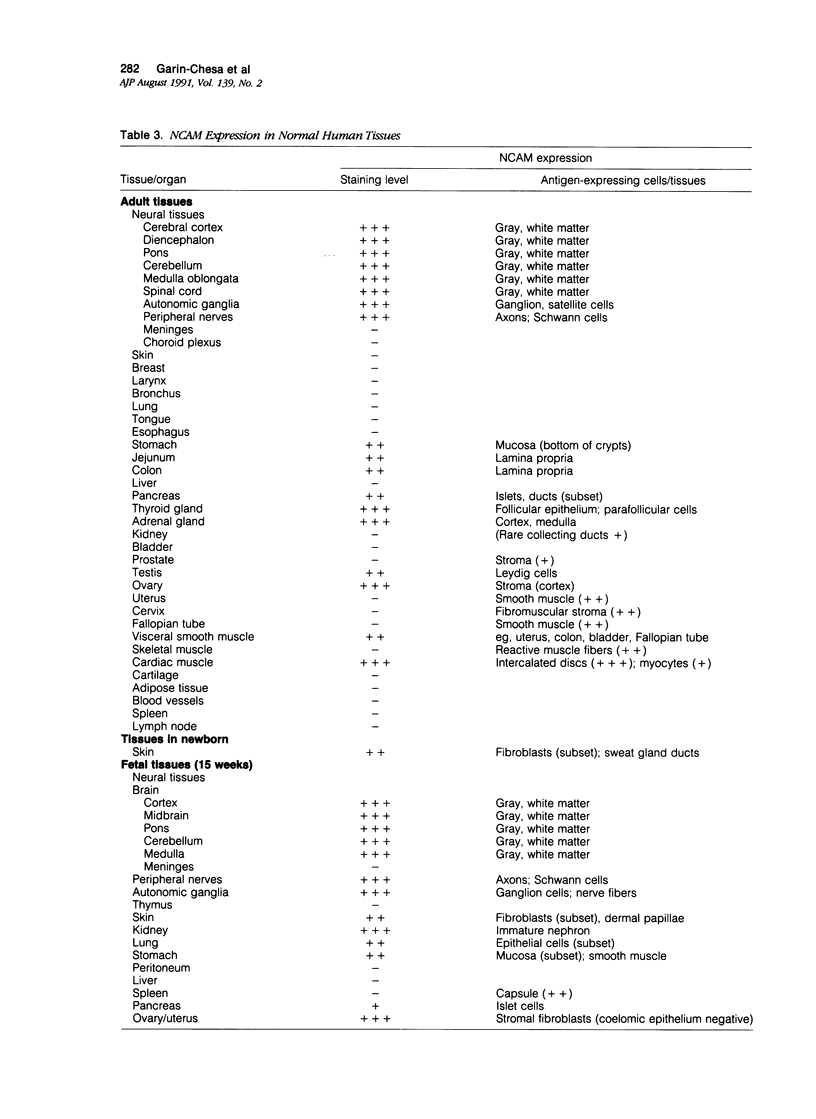
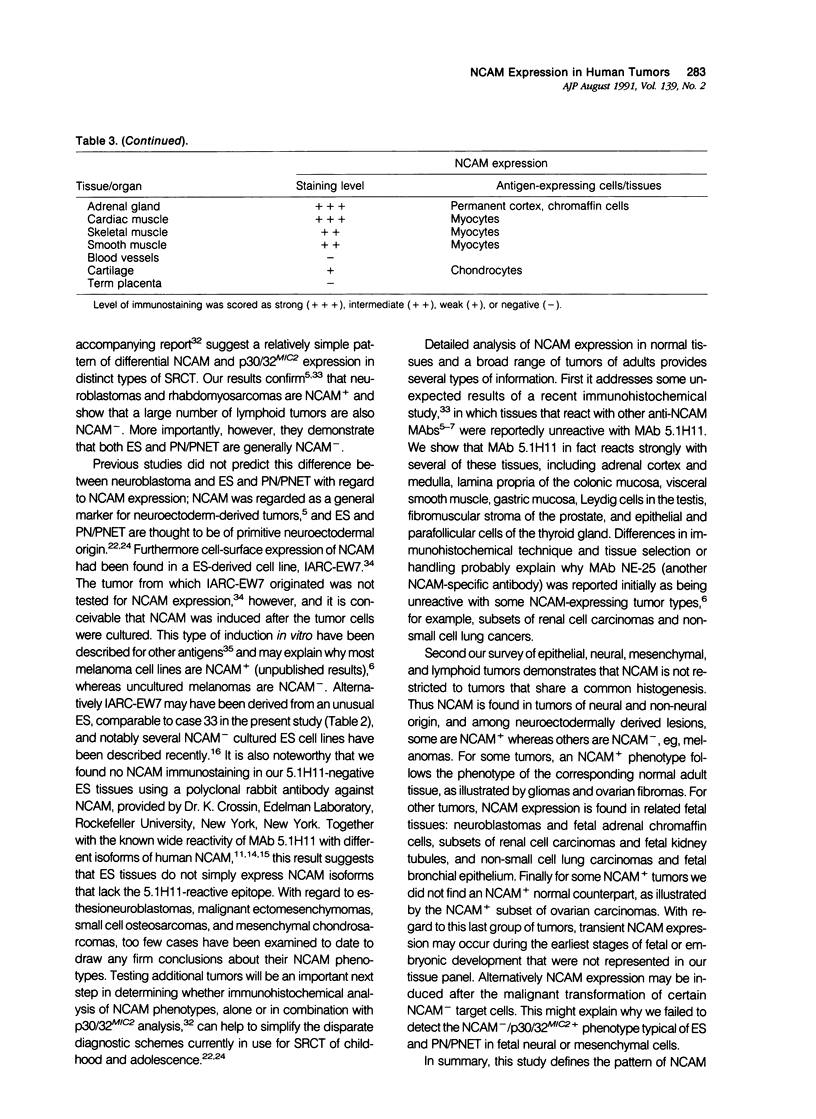
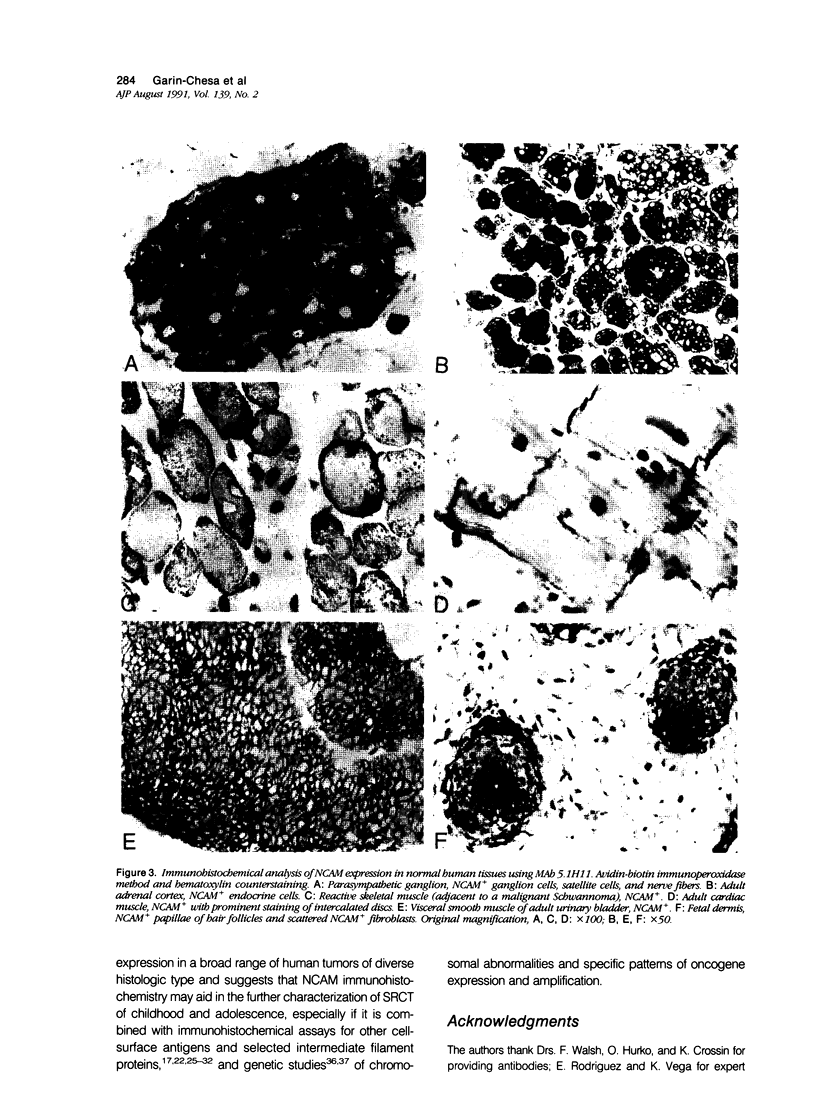
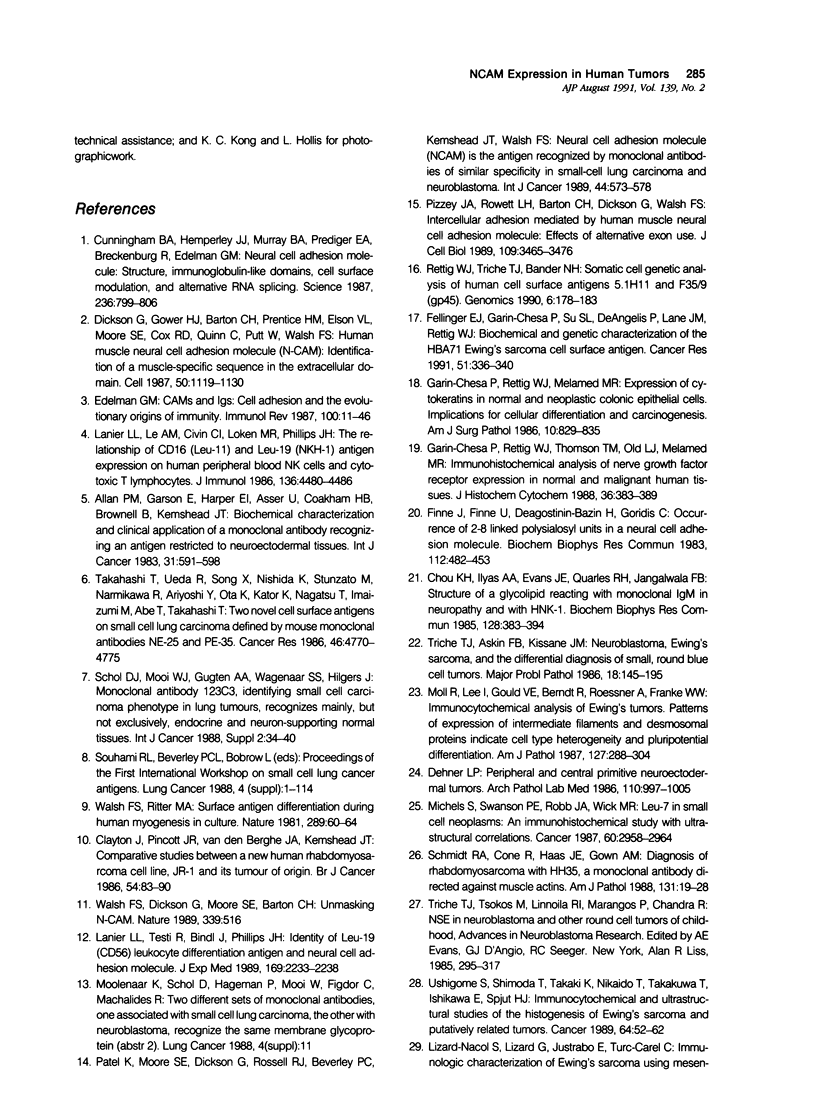

Images in this article
Selected References
These references are in PubMed. This may not be the complete list of references from this article.
- Allan P. M., Garson J. A., Harper E. I., Asser U., Coakham H. B., Brownell B., Kemshead J. T. Biological characterization and clinical applications of a monoclonal antibody recognizing an antigen restricted to neuroectodermal tissues. Int J Cancer. 1983 May 15;31(5):591–598. doi: 10.1002/ijc.2910310510. [DOI] [PubMed] [Google Scholar]
- Bloomfield C. D., Trent J. M., van den Berghe H. Report of the committee on structural chromosome changes in neoplasia. Cytogenet Cell Genet. 1987;46(1-4):344–366. doi: 10.1159/000132485. [DOI] [PubMed] [Google Scholar]
- Chang T. K., Li C. Y., Smithson W. A. Immunocytochemical study of small round cell tumors in routinely processed specimens. Arch Pathol Lab Med. 1989 Dec;113(12):1343–1348. [PubMed] [Google Scholar]
- Chesa P. G., Rettig W. J., Melamed M. R. Expression of cytokeratins in normal and neoplastic colonic epithelial cells. Implications for cellular differentiation and carcinogenesis. Am J Surg Pathol. 1986 Dec;10(12):829–835. doi: 10.1097/00000478-198612000-00001. [DOI] [PubMed] [Google Scholar]
- Chesa P. G., Rettig W. J., Thomson T. M., Old L. J., Melamed M. R. Immunohistochemical analysis of nerve growth factor receptor expression in normal and malignant human tissues. J Histochem Cytochem. 1988 Apr;36(4):383–389. doi: 10.1177/36.4.2831267. [DOI] [PubMed] [Google Scholar]
- Chou K. H., Ilyas A. A., Evans J. E., Quarles R. H., Jungalwala F. B. Structure of a glycolipid reacting with monoclonal IgM in neuropathy and with HNK-1. Biochem Biophys Res Commun. 1985 Apr 16;128(1):383–388. doi: 10.1016/0006-291x(85)91690-0. [DOI] [PubMed] [Google Scholar]
- Clayton J., Pincott J. R., van den Berghe J. A., Kemshead J. T. Comparative studies between a new human rhabdomyosarcoma cell line, JR-1 and its tumour of origin. Br J Cancer. 1986 Jul;54(1):83–90. doi: 10.1038/bjc.1986.155. [DOI] [PMC free article] [PubMed] [Google Scholar]
- Cunningham B. A., Hemperly J. J., Murray B. A., Prediger E. A., Brackenbury R., Edelman G. M. Neural cell adhesion molecule: structure, immunoglobulin-like domains, cell surface modulation, and alternative RNA splicing. Science. 1987 May 15;236(4803):799–806. doi: 10.1126/science.3576199. [DOI] [PubMed] [Google Scholar]
- Dehner L. P. Peripheral and central primitive neuroectodermal tumors. A nosologic concept seeking a consensus. Arch Pathol Lab Med. 1986 Nov;110(11):997–1005. [PubMed] [Google Scholar]
- Dickson G., Gower H. J., Barton C. H., Prentice H. M., Elsom V. L., Moore S. E., Cox R. D., Quinn C., Putt W., Walsh F. S. Human muscle neural cell adhesion molecule (N-CAM): identification of a muscle-specific sequence in the extracellular domain. Cell. 1987 Sep 25;50(7):1119–1130. doi: 10.1016/0092-8674(87)90178-4. [DOI] [PubMed] [Google Scholar]
- Edelman G. M. CAMs and Igs: cell adhesion and the evolutionary origins of immunity. Immunol Rev. 1987 Dec;100:11–45. doi: 10.1111/j.1600-065x.1987.tb00526.x. [DOI] [PubMed] [Google Scholar]
- Fellinger E. J., Garin-Chesa P., Su S. L., DeAngelis P., Lane J. M., Rettig W. J. Biochemical and genetic characterization of the HBA71 Ewing's sarcoma cell surface antigen. Cancer Res. 1991 Jan 1;51(1):336–340. [PubMed] [Google Scholar]
- Fellinger E. J., Garin-Chesa P., Triche T. J., Huvos A. G., Rettig W. J. Immunohistochemical analysis of Ewing's sarcoma cell surface antigen p30/32MIC2. Am J Pathol. 1991 Aug;139(2):317–325. [PMC free article] [PubMed] [Google Scholar]
- Finne J., Finne U., Deagostini-Bazin H., Goridis C. Occurrence of alpha 2-8 linked polysialosyl units in a neural cell adhesion molecule. Biochem Biophys Res Commun. 1983 Apr 29;112(2):482–487. doi: 10.1016/0006-291x(83)91490-0. [DOI] [PubMed] [Google Scholar]
- Ladanyl M., Heinemann F. S., Huvos A. G., Rao P. H., Chen Q. G., Jhanwar S. C. Neural differentiation in small round cell tumors of bone and soft tissue with the translocation t(11;22)(q24;q12): an immunohistochemical study of 11 cases. Hum Pathol. 1990 Dec;21(12):1245–1251. doi: 10.1016/s0046-8177(06)80038-9. [DOI] [PubMed] [Google Scholar]
- Lanier L. L., Le A. M., Civin C. I., Loken M. R., Phillips J. H. The relationship of CD16 (Leu-11) and Leu-19 (NKH-1) antigen expression on human peripheral blood NK cells and cytotoxic T lymphocytes. J Immunol. 1986 Jun 15;136(12):4480–4486. [PubMed] [Google Scholar]
- Lanier L. L., Testi R., Bindl J., Phillips J. H. Identity of Leu-19 (CD56) leukocyte differentiation antigen and neural cell adhesion molecule. J Exp Med. 1989 Jun 1;169(6):2233–2238. doi: 10.1084/jem.169.6.2233. [DOI] [PMC free article] [PubMed] [Google Scholar]
- Lipinski M., Hirsch M. R., Deagostini-Bazin H., Yamada O., Tursz T., Goridis C. Characterization of neural cell adhesion molecules (NCAM) expressed by Ewing and neuroblastoma cell lines. Int J Cancer. 1987 Jul 15;40(1):81–86. doi: 10.1002/ijc.2910400115. [DOI] [PubMed] [Google Scholar]
- McKeon C., Thiele C. J., Ross R. A., Kwan M., Triche T. J., Miser J. S., Israel M. A. Indistinguishable patterns of protooncogene expression in two distinct but closely related tumors: Ewing's sarcoma and neuroepithelioma. Cancer Res. 1988 Aug 1;48(15):4307–4311. [PubMed] [Google Scholar]
- Michels S., Swanson P. E., Robb J. A., Wick M. R. Leu-7 in small cell neoplasms. An immunohistochemical study with ultrastructural correlations. Cancer. 1987 Dec 15;60(12):2958–2964. doi: 10.1002/1097-0142(19871215)60:12<2958::aid-cncr2820601218>3.0.co;2-j. [DOI] [PubMed] [Google Scholar]
- Moll R., Lee I., Gould V. E., Berndt R., Roessner A., Franke W. W. Immunocytochemical analysis of Ewing's tumors. Patterns of expression of intermediate filaments and desmosomal proteins indicate cell type heterogeneity and pluripotential differentiation. Am J Pathol. 1987 May;127(2):288–304. [PMC free article] [PubMed] [Google Scholar]
- Noguera R., Navarro S., Triche T. J. Translocation (11;22) in small cell osteosarcoma. Cancer Genet Cytogenet. 1990 Mar;45(1):121–124. doi: 10.1016/0165-4608(90)90074-k. [DOI] [PubMed] [Google Scholar]
- Patel K., Moore S. E., Dickson G., Rossell R. J., Beverley P. C., Kemshead J. T., Walsh F. S. Neural cell adhesion molecule (NCAM) is the antigen recognized by monoclonal antibodies of similar specificity in small-cell lung carcinoma and neuroblastoma. Int J Cancer. 1989 Oct 15;44(4):573–578. doi: 10.1002/ijc.2910440402. [DOI] [PubMed] [Google Scholar]
- Pizzey J. A., Rowett L. H., Barton C. H., Dickson G., Walsh F. S. Intercellular adhesion mediated by human muscle neural cell adhesion molecule: effects of alternative exon use. J Cell Biol. 1989 Dec;109(6 Pt 2):3465–3476. doi: 10.1083/jcb.109.6.3465. [DOI] [PMC free article] [PubMed] [Google Scholar]
- Rettig W. J., Old L. J. Immunogenetics of human cell surface differentiation. Annu Rev Immunol. 1989;7:481–511. doi: 10.1146/annurev.iy.07.040189.002405. [DOI] [PubMed] [Google Scholar]
- Rettig W. J., Triche T. J., Bander N. H. Somatic cell genetic analysis of human cell surface antigens 5.1H11 and F35/9 (gp45). Genomics. 1990 Jan;6(1):178–183. doi: 10.1016/0888-7543(90)90464-6. [DOI] [PubMed] [Google Scholar]
- Schmidt R. A., Cone R., Haas J. E., Gown A. M. Diagnosis of rhabdomyosarcomas with HHF35, a monoclonal antibody directed against muscle actins. Am J Pathol. 1988 Apr;131(1):19–28. [PMC free article] [PubMed] [Google Scholar]
- Schol D. J., Mooi W. J., van der Gugten A. A., Wagenaar S. S., Hilgers J. Monoclonal antibody 123C3, identifying small cell carcinoma phenotype in lung tumours, recognizes mainly, but not exclusively, endocrine and neuron-supporting normal tissues. Int J Cancer Suppl. 1988;2:34–40. doi: 10.1002/ijc.2910410711. [DOI] [PubMed] [Google Scholar]
- Strother D. R., Parham D. M., Houghton P. J. Expression of the 5.1 H11 antigen, a fetal muscle surface antigen, in normal and neoplastic tissue. Arch Pathol Lab Med. 1990 Jun;114(6):593–596. [PubMed] [Google Scholar]
- Takahashi T., Ueda R., Song X., Nishida K., Shinzato M., Namikawa R., Ariyoshi Y., Ota K., Kato K., Nagatsu T. Two novel cell surface antigens on small cell lung carcinoma defined by mouse monoclonal antibodies NE-25 and PE-35. Cancer Res. 1986 Sep;46(9):4770–4775. [PubMed] [Google Scholar]
- Ushigome S., Shimoda T., Takaki K., Nikaido T., Takakuwa T., Ishikawa E., Spjut H. J. Immunocytochemical and ultrastructural studies of the histogenesis of Ewing's sarcoma and putatively related tumors. Cancer. 1989 Jul 1;64(1):52–62. doi: 10.1002/1097-0142(19890701)64:1<52::aid-cncr2820640110>3.0.co;2-6. [DOI] [PubMed] [Google Scholar]
- Walsh F. S., Dickson G., Moore S. E., Barton C. H. Unmasking N-CAM. Nature. 1989 Jun 15;339(6225):516–516. doi: 10.1038/339516a0. [DOI] [PubMed] [Google Scholar]
- Walsh F. S., Ritter M. A. Surface antigen differentiation during human myogenesis in culture. Nature. 1981 Jan 1;289(5793):60–64. doi: 10.1038/289060a0. [DOI] [PubMed] [Google Scholar]





